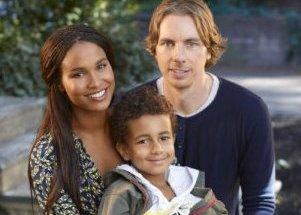Tuesday marks the national occasion on which the Southern Poverty Law Center calls on high school students around the country to break new ground in their noontime friendships and “mix it up” by dining and chatting with someone outside their circle. It’s called “National Mix It Up at Lunch Day,” and we all could take a lesson in getting along. Notable though is the fact that television producers — comedy and drama — seem to be making their own moves to break tradition and introduce audiences to the fact that a growing segment of the U.S. population is multiracial families.
Interracial or interethnic opposite-sex married couple households grew by 28 percent over the last decade, increasing from 7 percent in 2000 to 10 percent in 2010, according to the Census Bureau. States with higher percentages of couples of a different race or Hispanic origin in 2010 were primarily located in the western and southwestern parts of the United States, along with Hawaii and Alaska.
Daytime TV, of course, dared to show African-American actors in dramatic roles and even taboo romances a while ago. Prime time producers occasionally dipped their toes into the chilly waters of chance, but dramas and comedies this fall are “mixing it up,” perhaps more than ever.
No producer mixes cast and circumstances more than Shonda Rhimes. Her characters in Grey’s Anatomy (above), then Private Practice (top) attracted audiences who accepted that love crosses racial and gender lines and the Republic would stand.
And speaking of the Republic, Rimes, who has said that
Grey’s and
Practice are winding down, kicked “Mix It Up” a notch higher by showing in
Scandal (right) that a smitten American president can lose his political bearings (and his pants) over a sensationally hot Kerry Washington.
Give
Parenthood (below) credit for conveying family complexity, including a biracial couple (Joy Bryant and Dax Shepard) who have a son (Tyree Brown) and grapple with all manner of issues, including — honestly enough — race. One particularly poignant episode recently dealt with young Jabbar being in his father’s recording studio when a rapper uses the N word. The mother talked to the boy about what he heard. The father felt pushed aside on this pivotal teachable moment, but ultimately understood that his credibility on the topic was modest at best.

The primetime landscape is increasingly diverse, but by no means a Utopia. And in among data crunchers, that might be closer to reality. Most white Americans live in neighborhoods where the overwhelming majority of their neighbors are white, according to an Associated Press interview with sociologist Charles Gallagher of Georgia State University. Gallagher was interviewed for a story about the increased number of multi-racial families portrayed in commercials.
In an odd sort of twist, television programs convey circumstances that don’t widely exist in reality. But for a national audience that spends very little time making friends outside their ethnic group, prime time marks a step toward mixing it up. A really terrific idea would be for audiences whose program choices veer away from diversity to take a day to mix it up by watching a show they might not otherwise give the time of day. And that doesn’t include Honey Boo Boo.